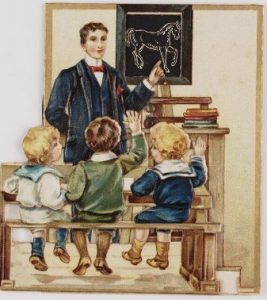
“We hopped on the bus near the Ospedale Maggiore di Bologna, having purchased our biglietti for Euro 1.50, and found we could ride the autobus, through the medieval cobbled streets of the city, in any direction for ninety minutes”.
Our Partnership team were in Bologna, Italy last week. We were attending the Children’s Book Fair to meet with publishers, authors and artists, and to soak up the atmosphere of world class creativity and dynamism that is the book trade for children in Italy.
Being regular attenders at the London Book Fair, it was noticeable that, although the giant Amazon had a media stand at the week in Bologna, there was nothing like the all pervading presence they seemed to have in London earlier in the year.
Indeed, for the retail giant Italy is still a market in development. We noted that “…Amazon’s Prime service offers one-day delivery of a million products in 6,000 Italian towns and 2-3 days for the rest of the country“. Read more here… Source: Italy24 web pages.

With a significant Amazon building and development programme in Italy under way, the diversity and complexity of the other international publishing presences in Bologna, from traditional publishers to independent writers, artists and agents, was a sign that the trade in Italy is perhaps conditioned and delivered still in a very traditional way. Affording much opportunity for disruptive innovation in retail distribution we suspect.
As a micro-publisher, establishing our own tentative foothold in the Italian market, what was stunningly noticeable was the available space and ease with which new graphic artists, illustrators and designers could display their work.
Whatever language children are reading in, the quality of the illustrative art applied to the story enhances and opens that bridge to the imagination. It is as important as the ‘book’ itself, or the page layout or font choice, we would argue. The simplest narrative story can become an exciting page turner with the addition of wonderful artistic creativity. There was much of it evident in Italy last week.
Entering the exhibition halls at the event in Bologna Fiere was like stepping into a giant gallery. With a fantastic display of artwork in the principal foyer, annexed to a series of giant display boards for the young and independent artist to display samples of their work. Although the book trade is about business, the Italian approach led with free form creativity and individual design expertise in a way that we felt was unusual in the English book trade.
Some simple highlights for us during the week…

Marco Bonatti
We enjoyed the informal display of Marco’s work. He produces character with a gentle style, with which to enhance any children’s story, we felt. Engaging, friendly but equally up to the illustration of a more challenging narrative.
Based in Desenzano del Gardo, Italy – you can find Marco Bonatti’s work on the web here.
Katie Rewse

Katie both studies and lectures in the Arts at Bournemouth University. She also runs Seablue Designs, a wonderfully evocative title for her business, which encompasses oceanic themes and a subtle and diverse range of blue in her work.
Katie’s palette, even informally displayed, is striking when seen from a distance, which is what caught our eye, but is equally as powerful on the page when feeding a child’s imagination.
See Katie’s work on the web here.
Natasha Durley

Another graduate of Bournemouth University Arts faculty, Natasha produces images of plants and animals that are bold in structure and colour, but which are always seemingly ‘anatomically’ sound and proportionally framed.
We liked her structured pattern work particularly, standing out as it did from many of her contemporaries on display in Bologna.
You can find Natasha’s award winning work on the web here.
Alessandra Fusi

An artist and animation specialist, resident in Bologna, Alessandra has exhibited her work across not only Italy, but also Europe and the USA.
Her pen work was superb we thought, creating striking black and white images for her clients.
Alessandra has an ability to portray character through her artistry, but holds her style very much in the traditional fairytale mannerism, to which she expresses an enduring fascination.
You can see Alessandra’s work on the web here.
(All artist featured images captured from the Bologna Children's Fair ad-hoc display boards in 2017. Copyright remains entirely with the individual artist).
It was the artistry and illustrative energy that was the touchstone experience for us in Bologna this year. Although we were able to build a number of new partnerships and projects for 2017/2018, it is the imprint of ‘the image’ that will stay with us, particularly the energy of the work typical of the artists we have championed above.
Historical linearity in illustration:
We were looking, on behalf of another project before our departure for mainland Europe last week, at the history of children’s book illustration. The Digital Bodleian in Oxford have a wonderful new web resource featuring a number of historic children’s books and games.
You can trace a linear development between the Bodleian web holdings, many dating from the beginning of the Nineteenth Century, through to the modern day.
Not only in their stories about children, but also how the imaginative landscape is pictured, focused on illustration as we are in this article. Innovation was the driving force even then.

We particularly liked the game Choriama, dating from 1824, which serves as a ‘youth’s instructor’ in the drawing and colouring of landscape. The work being made up of a number of individual landscape sections, which can be folded and re-folded to create new topographies of play. See more at the Digital Bodleian here.

We also warmed to depictions of A Round of Fun. Pleasant illustrations of classroom activity where imagination and fun, with guidance , are the focus of the day’s activity. Is this not how school should be?
This work, in the Digital Bodleian, was created in England but was printed in Germany. See more of the Round of Fun at the Digital Bodleian on the web here.
Our whole Digital Bodleian experience, looking back, has been resonant with echoes of our contemporary take on the Book Fair in Bologna.
Creative and imaginative illustrations, some classical and others traditional in feel, the many with a modernist take on old themes – the whole utilising the practised hand of the artist, European production skills and education marketing. A creative journey from the Nineteenth Century to now, following enduring first principles.
Our biglietti:
We are already booking them for the 2018 event! Perhaps we may see another blue crocodile?
Editorial note on Italy:
Italians, in a recent report, the Bloomberg Global Health Index of 163 countries, lay claim to being some of the healthiest citizens in the world. Despite the prolonged downturn in the country’s economy and with up to 40% of the young unemployed.
It is the proximity to high art and culture, as well as a high vegetable and fruit diet, that must be responsible for the continual flowering of Italian artistic endeavour surely?









 The assembled audience were warmly welcomed by Professor David Humber, Provost of
The assembled audience were warmly welcomed by Professor David Humber, Provost of 
